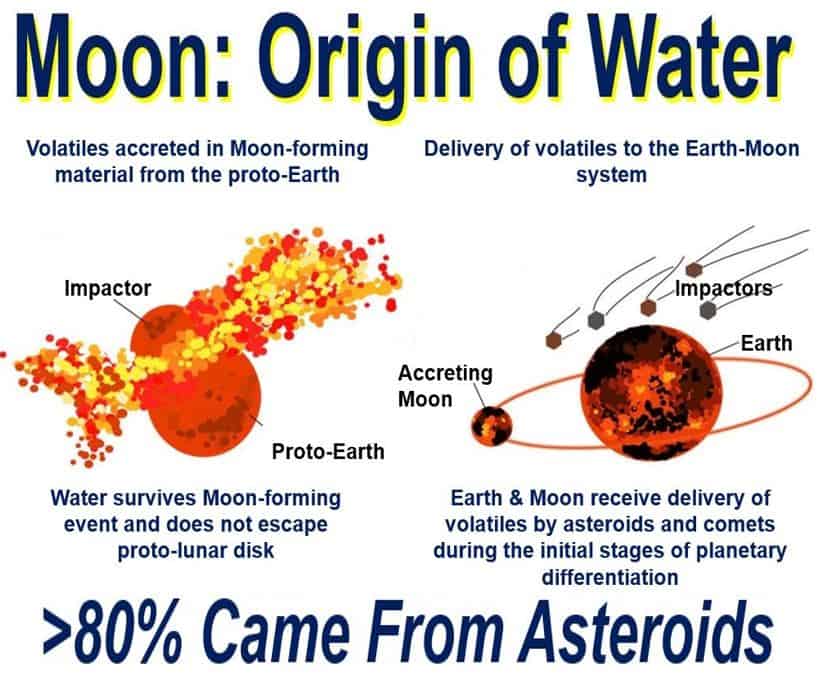There is water inside the Moon, and most of it came from asteroids (not comets) during its early evolution, between about 4.5 billion and 4.3 billion years ago, says an international team of scientists from the UK, the USA and France. This does not mean no water came from comets – just that most of it came from asteroids.
Dr. David Kring, from the Lunar and Planetary Institute in Houston, Texas, and colleagues from the UK’s Open University, the Natural History Museum in London, and the Muséum National d’Histoire Naturelle in Paris, wrote about their study and findings in the prestigious journal Nature Communications (citation below).
During the Apollo era, we regularly heard the Moon being described as a desolate place devoid of water. However, as analytical techniques improved, scientists soon realised that there was water in the lunar interior.
 Volatiles were accreted (added, accumulated) to the Moon during its formation (left) and/or continuously delivered by impacting bodies during the 10–200 million years of crystallization of the lunar magma ocean (right). This drawing is not to scale. (Image: nature.com)
Volatiles were accreted (added, accumulated) to the Moon during its formation (left) and/or continuously delivered by impacting bodies during the 10–200 million years of crystallization of the lunar magma ocean (right). This drawing is not to scale. (Image: nature.com)
Discovering lunar water triggered new question
Initially, we were not able to detect any water in the lunar samples that were originally brought back to Earth. When our technology advanced and water was finally detected, it immediately triggered a new question: “Where did this water come from?”
In this latest study, scientists compared the chemical and isotopic composition of lunar volatiles, including water, with meteoritic samples of asteroids and volatile materials in comets.
They then calculated how much water those two celestial bodies could have delivered to the Moon. Their results suggest that more than 80% of the water in the interior of the Moon came from asteroids that are similar to carbonaceous chondritic meteorites.
When that water was delivered, the Moon was still surrounded by a magma ocean, and before a massive crust – seen today as the bright white highlands of the Moon – prevented objects that crashed onto its surface from delivering significant amounts of material to the lunar interior.
 The Moon has small but potentially significant amounts of water. According to rock samples collected by the Apollo astronauts, the Moon’s interior contains ten to thirty parts per million water. (Image: Adapted from Wikipedia)
The Moon has small but potentially significant amounts of water. According to rock samples collected by the Apollo astronauts, the Moon’s interior contains ten to thirty parts per million water. (Image: Adapted from Wikipedia)
Within this same interval of time, a similar delivery of water to Earth would have been taking place.
In an Abstract which describes the main article in the journal, the researchers wrote:
“We determine that a combination of carbonaceous chondrite-type materials were responsible for the majority of water (and nitrogen) delivered to the Earth–Moon system.”
“Crucially, we conclude that comets containing water enriched in deuterium contributed significantly <20% of the water in the Moon. Therefore, our work places important constraints on the types of objects impacting the Moon ~4.5–4.3 billion years ago and on the origin of water in the inner Solar System.”
Difference between asteroids and comets
Comets and asteroids have several things in common. They are both celestial bodies that orbit the Sun, they have unusual orbits, and are ‘leftovers’ from materials from the formation of the Solar System 4.5 billion years ago.
While comets consist of ice, dust, rocky materials and organic compounds, asteroids are made up of rocky material and metals.
As comets get nearer to the Sun, they lose material because some of their ice melts and vaporizes. Asteroids, on the other hand, generally remain solid, even when close to the Sun.
Citation: “An asteroidal origin for water in the Moon,” Jessica J. Barnes, David A. Kring, Romain Tartèse, Ian A. Franchi, Mahesh Anand & Sara S. Russell. Nature Communications. 31 May 2016. DOI: 10.1038/ncomms11684.
Video – Water on the Moon
Scientists have been looking for water on the Moon, in its shaded regions, for a long time.
